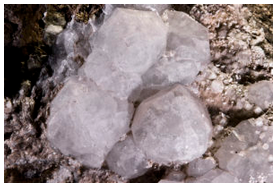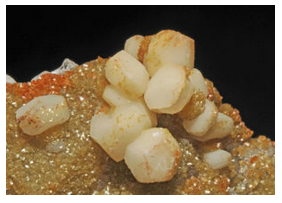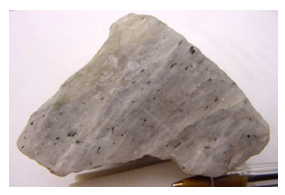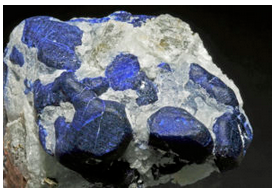6.4.4: Feldspathoids
- Page ID
- 18871
| Feldspathoids | |
| Some important species | |
| analcime leucite nepheline sodalite |
NaAlSi2O6∙H2O KAlSi2O6 NaAlSiO4 Na4(Al3Si3)O12Cl |
The feldspathoid minerals are framework silicates similar to feldspars in many of their properties. They are, however, much less common. Feldspathoids are a family of about a dozen minerals; they are all Na-, K-, and Ca-aluminosilicates. The family is not like other mineral groups, whose members are related by similar atomic arrangements and chemistries. Instead these minerals are grouped together because of their relationship to feldspars. The blue box lists some examples of feldspathoids and their formulas.




The photos above in Figures 6.58 to 6.61 show the most common feldspathoids. They have compositions that are, for the most part, equivalent to silica-deficient feldspars. These minerals commonly crystallize from magmas that are relatively low in SiO2 or that contain more Na, K, and Al than can fit into feldspars. These minerals have large openings in their atomic arrangements that allow the minerals to contain significant amounts of large anions and molecular anions, including chlorine, carbonate, and sulfate. They often occur with feldspars, and also with mafic minerals including amphiboles, olivine, and pyroxenes, but never with quartz. They are restricted to quartz-free rocks because they will react with quartz to produce feldspars by reactions such as:
blankNaAlSi2O6∙H2O + SiO2 = NaAlSi3O8 + H2O
blankanalcime + quartz = albite + vapor
blankKAlSi2O6 + SiO2 = KAlSi3O8
blankleucite + quartz = orthoclase
blankNaAlSiO4 + 2 SiO2 = NaAlSi3O8
blanknepheline + 2 quartz = albite
Analcime, a zeolite, is often considered to belong to the feldspathoid family. Other important feldspathoids include leucite, nepheline, sodalite, and lazurite. Leucite is a rare mineral found in K-rich volcanic rocks. It is unknown in plutonic, metamorphic, or sedimentary rocks. Nepheline is a common mineral in syenite and other silica-poor volcanic or plutonic igneous rocks. Leucite and nepheline are usually associated with K-feldspar. Sodalite crystallizes from alkali-rich magmas and is also found in some metamorphosed carbonate rocks. Analcime also can crystallize from a magma, but it more commonly forms as a secondary mineral in vugs, cracks, or veins. Occasionally it is found as a secondary mineral in sandstones or tuffs. When it crystallizes from a magma, it is typically associated with olivine, leucite, and perhaps sodalite. When it is secondary, other low-temperature minerals, including zeolites or prehnite, often accompany it.


